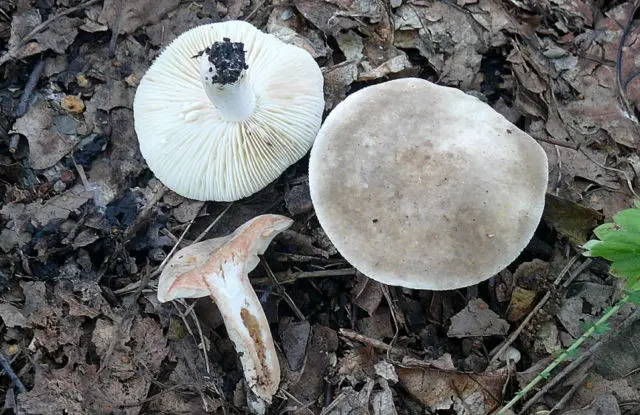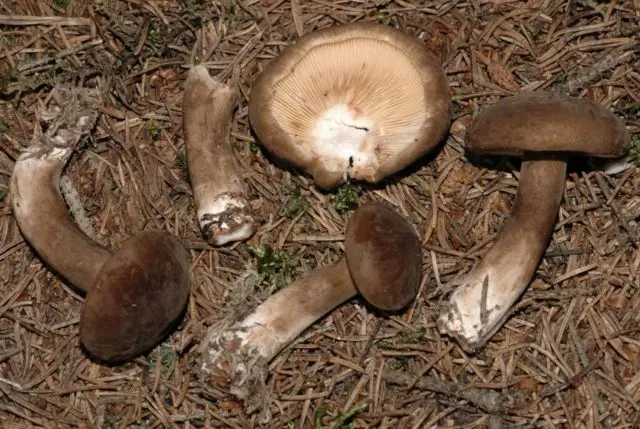Contents
The zoneless milky, or zoneless, belongs to the Russula family, the Milky genus. The fungus is lamellar, secretes milky juice on the cut, is edible.
Where does the zoneless milkweed grow?
It grows in deciduous forests, where there are oaks, with which it forms mycorrhiza. Distributed in Eurasia. On the territory of Our Country, zoneless lactifers are found in southern regions, such as the Krasnodar Territory. Grows in groups, often numerous. Fruiting from August to September. Prefers damp, shady places.
What does a zoneless milker look like?
Cap size up to 10 cm in diameter. The shape is usually flat, sometimes concave, there is a small tubercle in the center, the edges are even. The surface is dry, smooth, becomes sticky in damp weather. Its flesh is elastic and dense. Color – from sandy and light brown to rich brown and dark brown, sometimes with gray shades.
The height of the leg is 3-7 cm, the diameter is 1 cm. The shape is cylindrical, regular. The surface is smooth. In young specimens it is solid, in old specimens it is hollow. The pulp is elastic, dense. The color is like a hat or a little lighter.

So the mushroom looks like in a section
The plates are narrow, slightly descending along the stem, grow to it. The spore-bearing layer is white or milky, gradually darkens, becomes buffy. Creamy powder, fusiform spores.
The flesh is white, dense, slightly pinkish on the cut. The taste is insipid, bitterness appears in mature specimens. Old mushrooms have a slightly spicy aroma. The milky juice is white, after reaction with air it acquires a pinkish-orange hue.
Is it possible to eat a zoneless milker
The mushroom is edible. Belongs to the fourth taste category.
False twins of the zoneless milky
Milky is wet. Another name is grey-purple breast. In contrast to the zoneless, it has a domed, sticky, wet gray or purple-gray hat. Its size is from 4 to 8 cm. In old specimens, it becomes prostrate. The length of the leg is from 4 to 7 cm, the thickness is from 1 to 2 cm. It is dense, the surface is sticky to the touch. The pulp is spongy, tender. Belongs to rare species. It grows in moist deciduous forests on mosses. He loves the neighborhood of birches and willows. Found singly or in small groups. There is no exact information about the edibility, some authors classify it as conditionally edible.

Wet milky is easy to recognize by the wet surface of the cap
Milky resinous (black). A very rare mushroom. It differs from zoneless in dark color, but at a young age it is lighter and may look like it. The hat reaches a diameter of 3 to 8 cm. Its shape is first convex, then slightly depressed. Color brown-brown, brown-chocolate, brown-black. The leg is dense, cylindrical, reaches a height of 8 cm, a thickness of 1,5 cm. The color is the same as that of the cap, at the base it is white. The pulp is light and dense. Grows in coniferous and mixed forests singly or in groups. The fruiting period is August-September. There is no exact information about edibility.

Milky black dark color with a convex hat
Rules for collection and use
It is recommended to collect milkers only in wicker baskets in which there is ventilation, which means that they will be better preserved. They are laid with their hats down, specimens with long legs – sideways. Remove from the ground with twisting movements. If in doubt, it is better not to pick the mushroom.
Zoneless milkers are not recommended to be consumed fresh. They are suitable for salting and pickling. Connoisseurs advise taking only young specimens.
Conclusion
The zoneless milker is a relative of the well-known russula. Its main difference from other representatives of the genus is the pinkish juice that stands out from the pulp.









